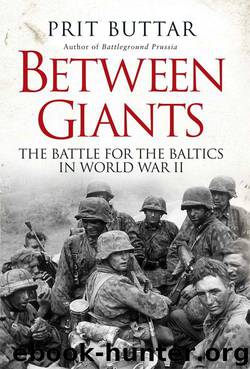Between Giants - The Battle for the Baltics in World War II by Prit Buttar

Author:Prit Buttar
Language: eng
Format: mobi, epub
Tags: Military History, World War II, Non fiction
ISBN: 9781472802880
Publisher: Osprey Publishing
Published: 2013-05-20T22:00:00+00:00
With Soviet forces now across the lower Narva in strength, the evacuation of the German troops within the city itself gained pace. The rearguard was made up of SS-Panzergrenadier-Regiment General Seyffard, a regiment of Dutch SS soldiers from the SS-Nederland brigade, reinforced by a battalion from the brigade’s SS-Panzergrenadier-Regiment De Ruyter and a pair of assault guns, with Rebane’s Estonians covering their northern flank and a battalion of SS-Panzergrenadier-Regiment Norge to the south. Obersturmbannführer Benner, the commander of Seyffard, was new to his command, relatively unfamiliar with the area, and matters were made worse when contact with higher commands was disrupted by Soviet artillery fire during the afternoon of 25 July. At 2130hrs, an Estonian messenger arrived in Benner’s headquarters in Narva, with the unwelcome news that Soviet forces had succeeded in cutting the road at Olgino. Benner immediately dispatched the battalion from De Ruyter and the two assault guns to help Rebane’s Estonian battalion reopen the road, and a night attack succeeded in driving back the Soviet forces. A further Soviet penetration a mile further west at Peeterristi was also cleared.
With Soviet troops still pressing the German defences to the south-west of Narva, a withdrawal was now urgent, but Benner signalled that he could not leave Narva at the designated time. Unsure about the safety of the road running through Olgino and Peeterristi, Benner ordered his men to withdraw along the railway line, to the south of the road. Rebane’s Estonians and the De Ruyter battalion safely withdrew along the road, while Seyffard slowly retreated along the railway line, leaving Narva at midnight and reaching Soldino, barely three miles to the west, at 0500hrs on 26 July. Further to the west, the railway ran through woodland, and rather than continue along this course, Benner decided to strike north-west to try to reach the road route. Moving slowly across marshy terrain, Seyffard was spotted by Soviet aircraft and came under near-continuous artillery and aerial attack.
By 0800hrs, the Dutch regiment was only a mile from Laagna, where German assault guns tried in vain to break through to the encircled rearguard. Unable to make any headway, Benner turned south, and shortly before he ordered his radio vehicles destroyed, learned that Repniku was still occupied by German forces, and decided to try to break through. At 1730hrs, Seyffard launched its last attack, unaware that the Germans had in any event been driven back from Repniku. Benner was killed in the opening moments of the attack, and within 30 minutes the regiment had been completely scattered. Many were killed, others taken prisoner. Only a small group of men led by Untersturmführer Nieuwendijk-Hoek escaped, reaching the Tannenberg Line a week later.21
On 26 July, Soviet troops moved into the deserted city of Narva, which had been reduced to ruins, mainly as a result of Soviet aerial and artillery bombardment, partly through deliberate demolitions by the retreating Germans. It is estimated that only 2 per cent of the city’s buildings were still standing.22 Although the Red Army
Download
Between Giants - The Battle for the Baltics in World War II by Prit Buttar.epub
This site does not store any files on its server. We only index and link to content provided by other sites. Please contact the content providers to delete copyright contents if any and email us, we'll remove relevant links or contents immediately.
The Radium Girls by Kate Moore(10929)
The Templars by Dan Jones(4199)
100 Deadly Skills by Clint Emerson(4095)
Rise and Kill First by Ronen Bergman(4029)
The Doomsday Machine by Daniel Ellsberg(3743)
The Rape of Nanking by Iris Chang(3532)
Killing England by Bill O'Reilly(3469)
Hitler in Los Angeles by Steven J. Ross(3452)
Stalin by Stephen Kotkin(3099)
12 Strong by Doug Stanton(3065)
Hitler's Monsters by Eric Kurlander(2741)
Darkest Hour by Anthony McCarten(2655)
Blood and Sand by Alex Von Tunzelmann(2617)
The Art of War Visualized by Jessica Hagy(2427)
Hitler's Flying Saucers: A Guide to German Flying Discs of the Second World War by Stevens Henry(2306)
The Code Book by Simon Singh(2223)
The Second World Wars by Victor Davis Hanson(2140)
Babylon's Ark by Lawrence Anthony(2079)
Tobruk by Peter Fitzsimons(2070)
